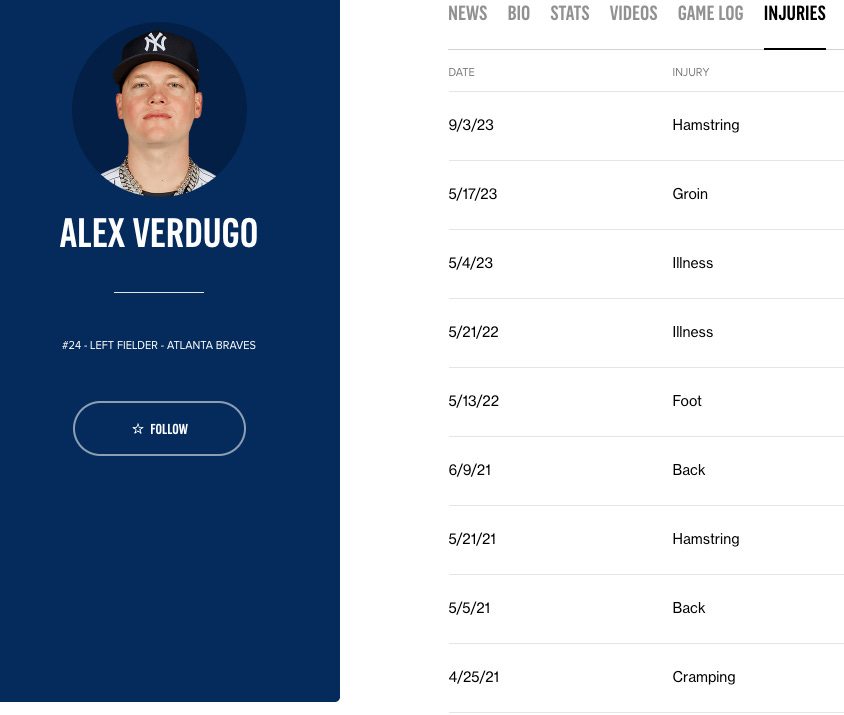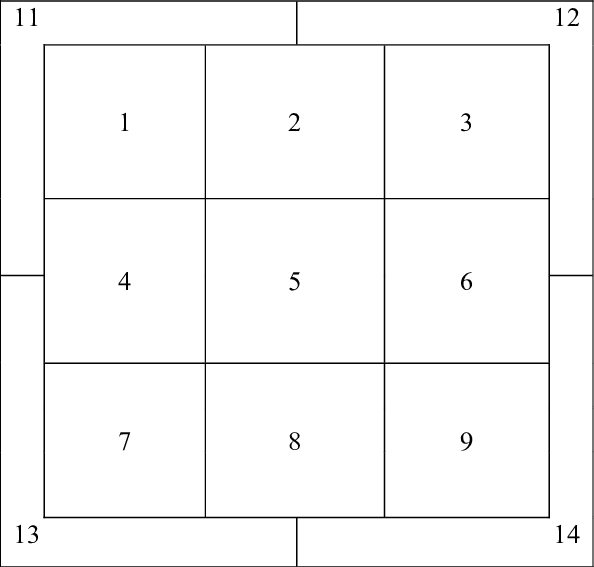What the Atlanta Braves saw in Alex Verdugo
The MLB veteran was surprisingly still available a week before Opening Day. But is this just a depth signing, or is there something more there?
Alex Anthopoulos is practically paranoid about depth.
Atlanta’s President of Baseball Operations has now lived through the great catching depth disaster of 20211 and not one, but two ‘on the fly’ outfield makeovers (2021 and 2024).
He’s not letting it happen again.
AA has added 34 seasons of MLB experience this week alone with the additions of reliever Craig Kimbrel, catcher James McCann, and now outfielder Alex Verdugo. It’s probably not the last addition the organization will make this week, either.
But is the addition of outfielder Alex Verdugo just a depth play, or is there something more to be unlocked in the 28-year-old’s game?
Let’s talk about it.
Who is Alex Verdugo?
‘Dougie’ is a former 2nd-round pick (Dodgers, 2014) who has spent time with some of the most storied franchises in baseball - the Los Angeles Dodgers (2014-2019), the Boston Red Sox (2020-2023), and the New York Yankees (2024).
He’s a career .272 hitter who received downballot MVP votes in 2020 after hitting .308/.367/.478 with six homers and 36 runs scored in the shortened season. He’s played in a World Series (2024 Yankees) and has twice been a finalist for a Gold Glove.
But there’s a flip side.
He’s also been declining offensively since his mid-20s, posting career lows in batting average (.233), OPS (.647), and OPS+ (83) last season. His once versatile outfield defense has become largely a corner profile, with the 28-year-old having not made a start in centerfield since 2021.
But there are still things to like, as well as areas that can be (hopefully) improved on.
What does he do well?
Despite my previous assertion, he’s still a good defender, he’s just confined to the corners due to below-average foot speed. Despite playing in Yankee Stadium’s expansive left field last year, Verdugo was worth +3 Fielding Run Value and put up +2 OAA, excelling both breaking in and back toward balls.
His arm remains one of the strongest in the league, with last year’s 92.1 mph arm strength coming in at the 94th percentile in all of baseball and the +3 Arm Value being 96th percentile. One season removed from leading the American League in outfield assists with 12, he still finished last year with seven assists from left as most baserunners respected his arm.
While his routes haven’t ever been crisp - he grades out negatively in every season of his career but the shortened 2020 season - he continues to have well above-average reaction time and his burst remains right around league average, leading to overall solid outfield scores no matter if he’s in left or right field.
Where is Verdugo lacking?
His offensive performance, as we mentioned earlier, has deteriorated…but I think it’s somewhat fixable.
First, it’s important to talk about what he’s not: A slugger. Verdugo’s career high for homers is 13, achieved in three separate seasons. This is owing to poor bat speed and a lack of overall power.
But there are things he does well, and this sometimes gets a bit lost. While he doesn’t have great overall power, he is making the most of it - his 33.4% “Squared-Up” rate2 was in Statcast’s 96th percentile.
He’s also making a lot of contact - Verdugo’s whiff rate of 15.5% last season was in the 93rd percentile, so one of the best in a league where the average hitter whiffs 25% of the time. This lack of whiffs shows in his zone contact rate of 90.5%, an outlier in a league where the average hitter sits at just 82%.
But you can’t utilize a high zone contact rate if you’re not swinging enough.
Subscription break! We’re adding more premium subs every single day - shout out to our newest premium subscriber Elizabeth, who signed up to an annual sub on Sunday afternoon. If you’re a frequent reader and/or find yourself really appreciating what we do both here and on the YouTube channel, which includes daily podcasts and video of media availabilities, why not become a paying member? It’s $6/month or $69 a year, and it helps support everything we’re going over here on Braves Today.
He’s too passive at the plate
This is where we get to the first area of improvement for Verdugo:
Being more aggressive in the zone
To reiterate the point, Verdugo’s one of the best in baseball at making contact inside the strike zone…but he just doesn’t swing enough. His 61.3% zone swing rate is below the MLB average, which sits pretty close to 70%.
Enter Tim Hyers
Remember one of his major tenets when it comes to hitting?
“You’re only as good as the strikes you swing at.”
Verdugo needs to swing at more strikes, especially when it’s his pitch. And his pitch is a breaking ball or changeup that’s out over the plate and either center-cut or down in the zone.
Of his 130 hits last season, 35% of them (37) came on a breaking or offspeed pitch in zones 4,5,6 or 83, including many of his doubles and several of his homers.
But he also had 67 called strikes on those same pitches. (Just for completion’s sake, he also had 12 whiffs and two foul balls.)
That seems pretty easy, right?
Telling a hitter “you should swing at more strikes” seems pretty easy, but helping them actually do that is a bit tougher.
For Verdugo, it all comes back to his struggles with fastballs.
The outfielder hasn’t been a good fastball hitter since 2022, when he hit .351 with a .513 slug off the pitch. I’m honestly not sure why but I’d guess he’s seen a drop in his bat speed…which conveniently isn’t publicly available for any season before 2023.
But there’s a clear correlation here, going from .351 to .266 to .232 against fastballs in three seasons and those corresponding seasons having batting averages also drop, from .280 to .264 to .233.4
Figuring out what caused that drop seems to be an important part of this whole “fixing Alex Verdugo” thing. For what it’s worth, he did really start dealing with injuries in 2021 and continuing up to last year. While he only went on the injured list once in his career, spending 55 days on there back in 2019 for an oblique strain, this rap sheet is pretty long:
Is it possible that nagging injuries have resulted in him being unable to catch up to heaters? Possibly.
(More supporting evidence that the injuries are sapping his raw skills - his speed went from a 70th percentile 27.6 ft/sec in 2020 to a 37th percentile 26.8 ft/sec by 2022…his age 26 season. That’s too early for an age-related decline.)
Opposing teams play a role here, too
There’s also the scouting report to consider. Verdugo’s hottest stretch last season was at the very beginning - through the first week of May, Verdugo hit .275 with a .812 OPS and clubbed five homers.
He hit .221 with just eight homers across the next 115 games to close the season.
So what changed?
Teams started throwing him more fastballs.
Verdugo’s percentage of fastballs bottomed out at 51.3% in early May but quickly rose to over 60%, peaking at 64.8% for August. So yes, you want him to pull the trigger more on changeups and breaking pitches in the zone, but it all comes back to being able to hit fastballs.
There’s another interesting tweak that teams made against him - throwing cutters. At that same time as the 51.3% fastball valley in May, Verdugo was seeing just 5.6% cutters. That quickly rose as high as 14.6%, with Verdugo finishing the year with a .158 batting average against the pitch and a -8 Run Value. While that wasn’t his worst mark - he was -9 against four-seam fastballs - it took 759 four-seamers to reach that -9 and just 216 cutters to reach the -8, meaning per 100 pitches (conveniently labeled on Statcast as RV/100), he was over three times as worse on cutters as he was on four-seam fastballs.5
Fix the fastballs, fix Verdugo
It’s as simple as that. If Alex Verdugo can even get back to respectable against fastballs (both four-seamers and cutters), then he’s likely going to see more of the pitches he’s actually good at hitting and can get back to someone who’s both a strong corner outfield defender and can flirt with being a .300 hitter.
And if you think about it, that’s just one thing. How hard can one thing be?6
The 2021 Atlanta Braves used seven different catchers during the regular season due to injuries to Travis d’Arnaud and William Contreras.
Explained simply, if you’re making close to optimal contact - achieving 80% or better of your max possible exit velocity on that specific pitch - that’s a squared-up swing.
Correlation is not causation, but I feel like these would pass a regression analysis.
And if you think about this, it totally tracks. If the guy is looking for breaking pitches out over the plate but can’t catch up to heaters, throw a fastball that looks like a breaking pitch and let the break take it from zone 8 to zone 7 (or 9, if you’re a lefty) for a whiff. I’d bust him inside with cutters all day and then flip a changeup away for the punchout.
“It’s not that hard. Tell ‘em, Wash.”





It’s not that hard, tell him Wash. this is in fact the greatest baseball quote ever. It can be used in nearly any situation or about any statistic or about any player. IYKYK
Tim Hyers enters the chat.
Could be a fix and trade situation?